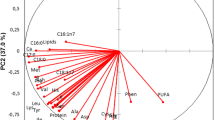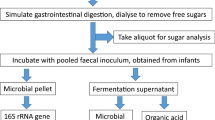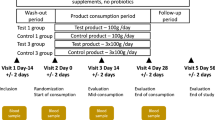Abstract
Objective:
To study the effects of consuming isoflavone aglycone-enriched soymilk fermented by bifidobacteria on urinary excretion of equol with respect to fermentation, daidzein dose, supplementation duration and background diet.
Design:
Double-blind crossover pilot study comprising three 14-day supplementation periods separated by a washout.
Setting:
Victoria University, Melbourne, Australia.
Subjects:
Sixteen postmenopausal women.
Intervention:
Subjects randomized into two groups consuming either fermented (FS) or non-fermented soymilk (NFS), ingested three daily dosages of daidzein via soymilk and collected pooled urine specimens. Daidzein and equol were quantified using high-performance liquid chromatography.
Results:
After 14-days supplementation six women (38%) excreted equol (>1 μmol equol/day), including four from the FS group, two of whom were classified as non-producers at day 4. Bifidobacteria ingestion, composition of daidzein and its glucosides, and carbohydrate intake appeared to influence equol formation among equol producers.
Conclusions:
Pilot-study group mean urinary equol excretion results provided insufficient evidence (P>0.05) that FS consumption instigates equol production in women predetermined as non-producers.
Sponsorship:
Australian Research Council's Strategic Partnership with Industry (Sanitarium Health Food Company) for Research and Training.
This is a preview of subscription content, access via your institution
Access options
Subscribe to this journal
Receive 12 print issues and online access
$259.00 per year
only $21.58 per issue
Buy this article
- Purchase on Springer Link
- Instant access to full article PDF
Prices may be subject to local taxes which are calculated during checkout

Similar content being viewed by others
References
Akaza H, Miyanaga N, Takashima N, Naito S, Hirao Y, Tsukamoto T et al. (2004). Comparisons of percent equol producers between prostate cancer patients and controls: case–controlled studies of isoflavones in Japanese, Korean and American residents. Jpn J Clin Oncol 34, 86–89.
Arora A, Nair MG, Strasburg GM (1998). Antioxidant activities of isoflavones and their biological metabolites in a liposomal system. Arch Biochem Biophys 356, 133–141.
Ballongue J (1993). Bifidobacteria and probiotic action. In: Salminen S, Von Wright A (eds). Lactic Acid Bacteria. Marcel Dekker: New York. pp 519–587.
Lu L-JW, Anderson KE (1998). Sex and long-term soy diets affect the metabolism and excretion of soy isoflavones in humans. Am J Clin Nutr 68, 1500S–1504S.
Morito K, Hirose T, Kinjo J, Hirakawa T, Okawa M, Nohara T et al. (2001). Interaction of phytoestrogens with estrogen receptors α and β. Biol Pharm Bull 24, 351–356.
Orrhage K, Nord CE (2000). Bifidobacteria and lactobacilli in human health. Drugs Exp Clin Res 26, 95–111.
Rowland IR, Wiseman H, Sanders TAB, Adlercreutz H, Bowey EA (2000). Interindividual variation in metabolism of soy isoflavones and lignans: influence of habitual diet on equol production by the gut microflora. Nutr Cancer 36, 27–32.
Setchell KDR, Brown N, Lydeking-Olsen E (2002). The clinical importance of the metabolite equol-a clue to the effectiveness of soy and its isoflavones. J Nutr 132, 3577–3584.
Setchell KDR, Maynard-Brown N, Desai PB, Zimmer-Nechemias L, Wolfe B, Jakate AS et al. (2003). Bioavailability, disposition, and dose–response effects of soy isoflavones when consumed by healthy women at physiologically typical dietary intakes. J Nutr 133, 1027–1035.
Tsangalis D, Ashton JF, McGill AEJ, Shah NP (2002). Enzymic transformation of isoflavone phytoestrogens in soymilk by β-glucosidase-producing bifidobacteria. J Food Sci 67, 3104–3113.
Tsangalis D, Wilcox G, Shah NP, Stojanovska L (2005). Bioavailability of isoflavone phytoestrogens in postmenopausal women consuming soya milk fermented with probiotic bifidobacteria. Br J Nutr 93, 867–877.
Xu X, Wang H-J, Murphy PA, Cook L, Hendrich S (1994). Daidzein is a more bioavailable soymilk isoflavone than is genistein in adult women. J Nutr 124, 825–832.
Acknowledgements
Australian Research Council's Strategic Partnership with Industry (Sanitarium Health Food Company) for Research and Training scheme funded this research. We thank Dr John Ashton of Sanitarium Health Food Company for his support and for providing the soy germ powder required for soymilk manufacture.
Author information
Authors and Affiliations
Corresponding author
Additional information
Guarantor: D Tsangalis.
Contributors: DT, GW, NPS and LS were responsible for planning the study, preparing the application for ethics approval and writing the paper. DT, GW and LS were involved in volunteer recruitment. DT manufactured the soymilk, processed the urine specimens and carried out the laboratory testing. DT and NPS collated, calculated and statistically analysed the data. AEJM has provided critical input into the paper.
Rights and permissions
About this article
Cite this article
Tsangalis, D., Wilcox, G., Shah, N. et al. Urinary excretion of equol by postmenopausal women consuming soymilk fermented by probiotic bifidobacteria. Eur J Clin Nutr 61, 438–441 (2007). https://doi.org/10.1038/sj.ejcn.1602530
Received:
Revised:
Accepted:
Published:
Issue Date:
DOI: https://doi.org/10.1038/sj.ejcn.1602530
Keywords
This article is cited by
-
Bioconversion of soy isoflavones daidzin and daidzein by Bifidobacterium strains
Applied Microbiology and Biotechnology (2009)
-
Age-stratified serum levels of isoflavones and proportion of equol producers in Japanese and Korean healthy men
Prostate Cancer and Prostatic Diseases (2008)



